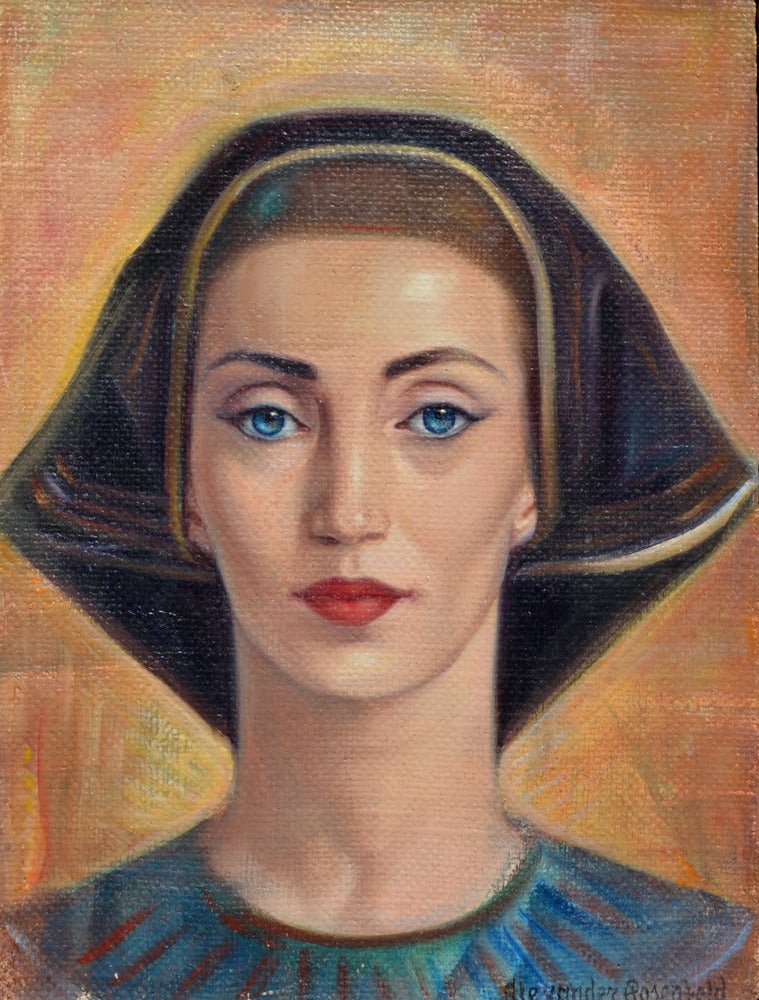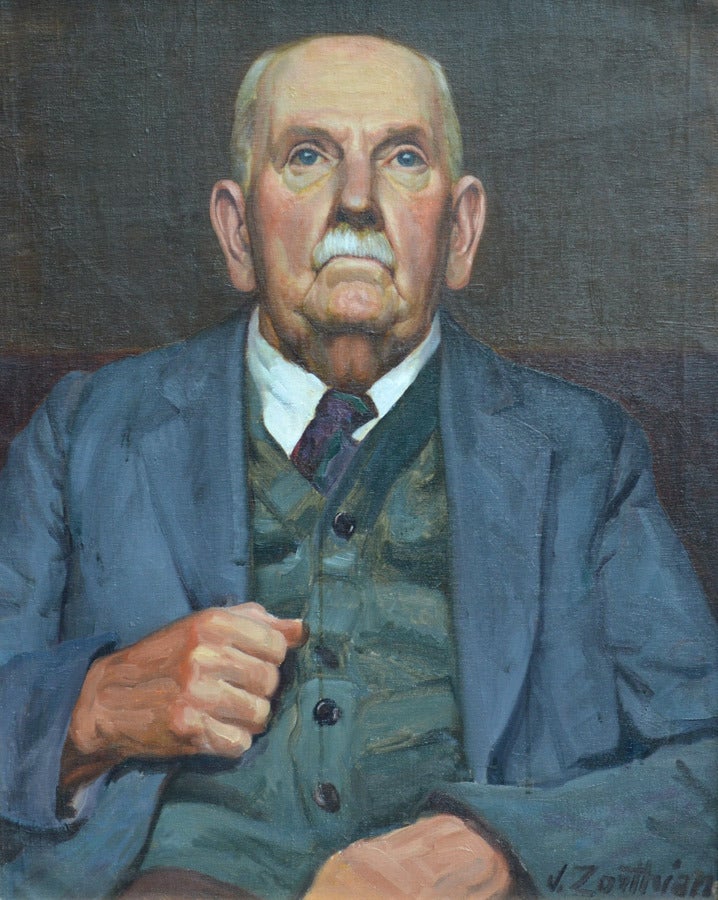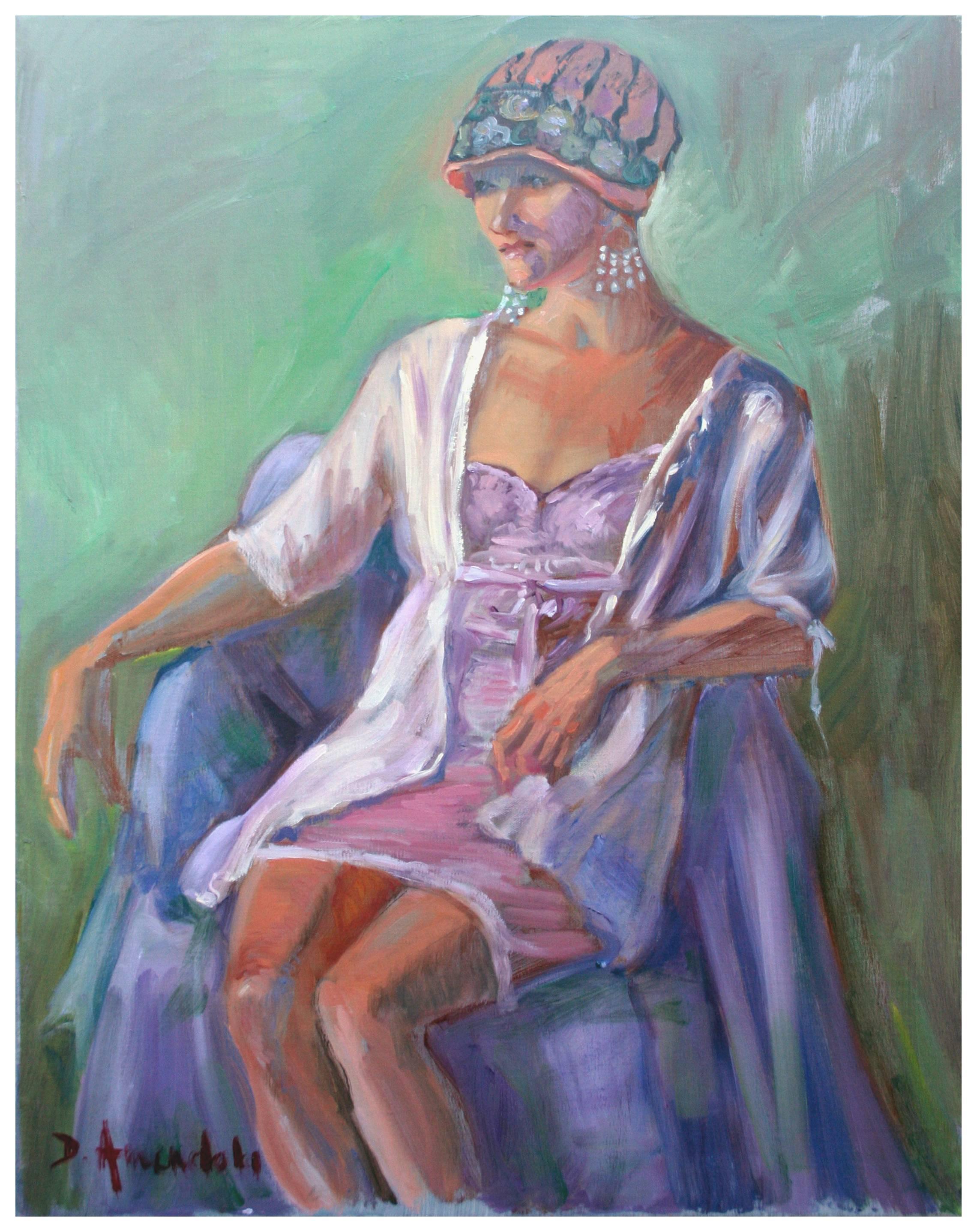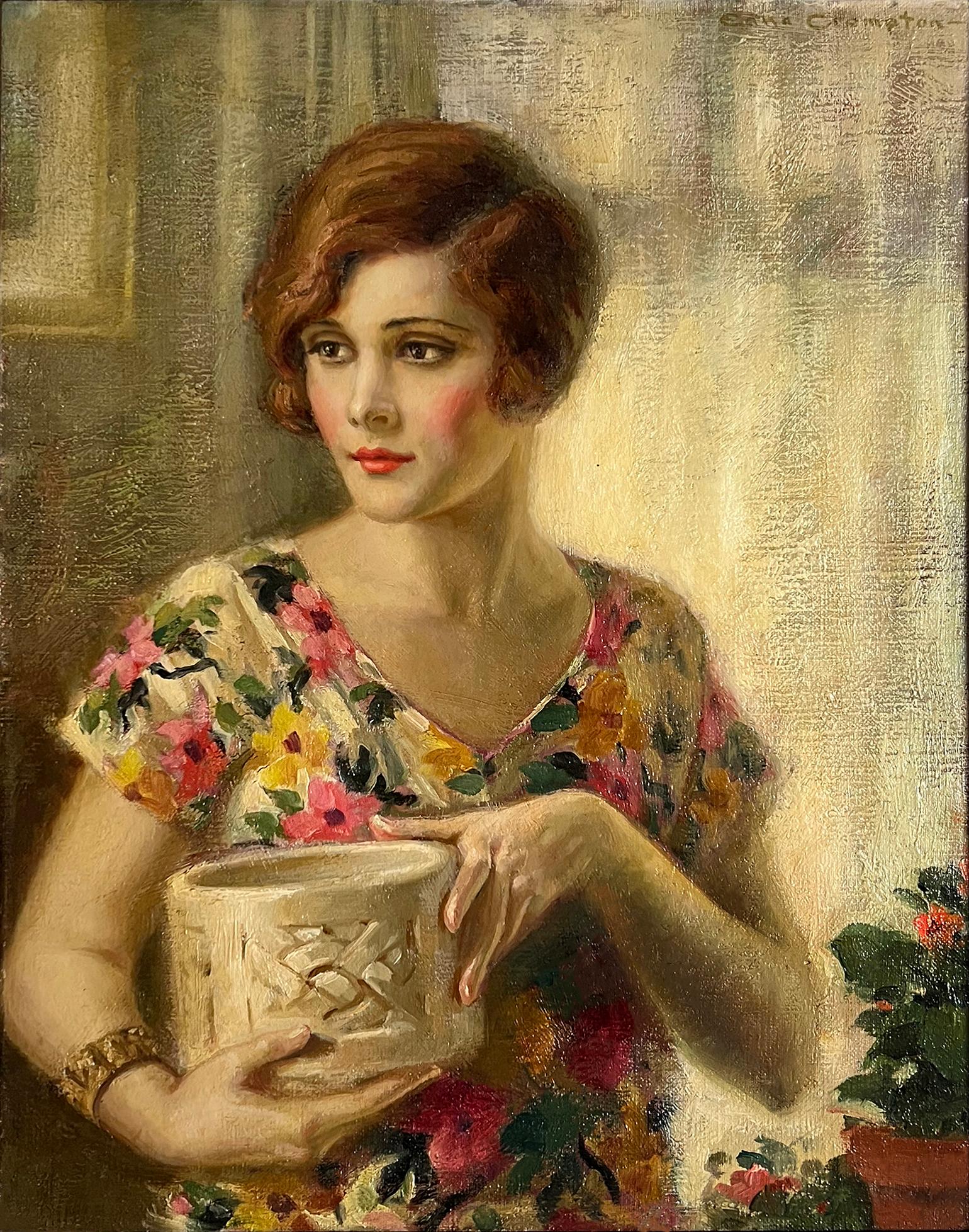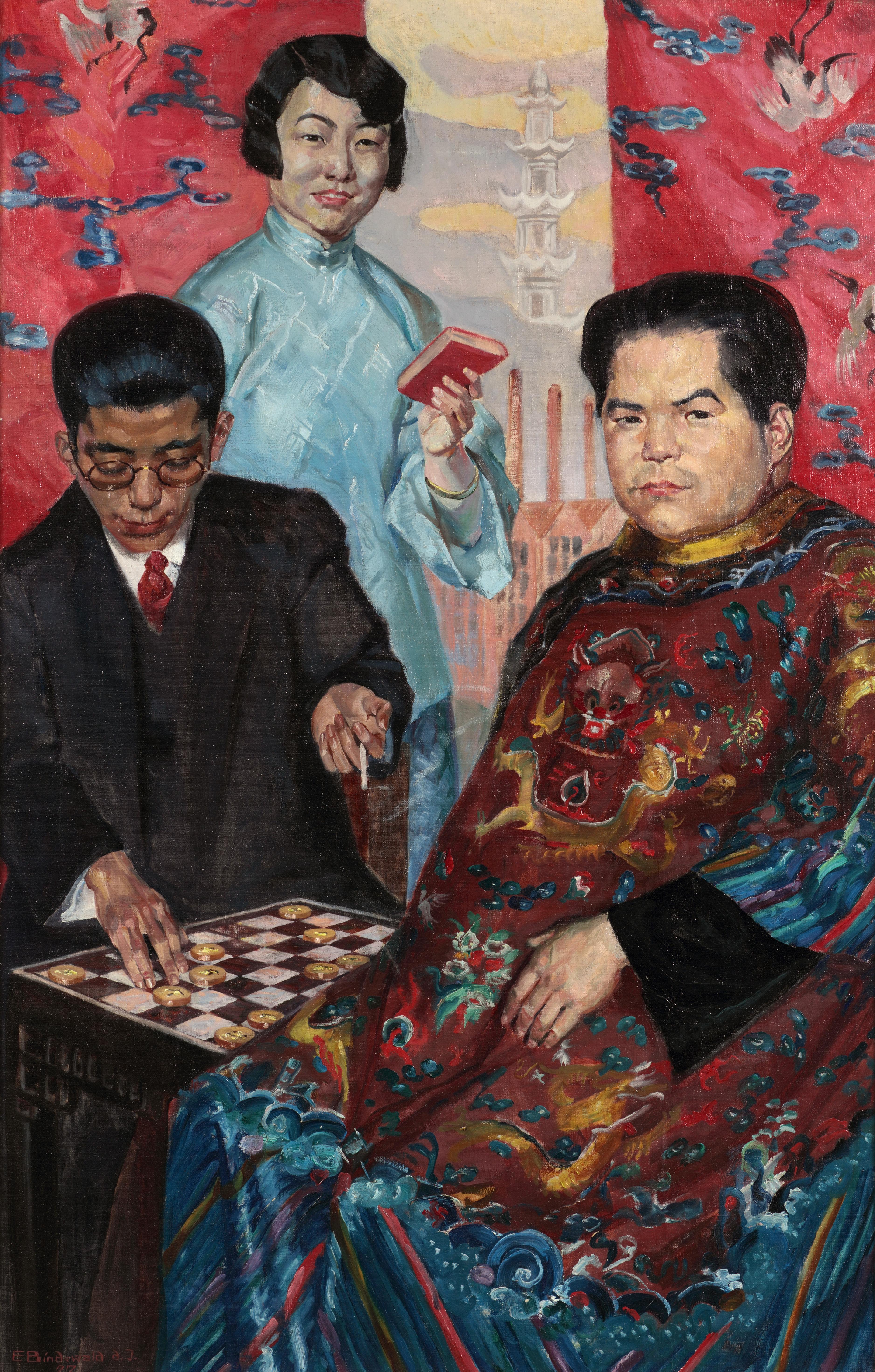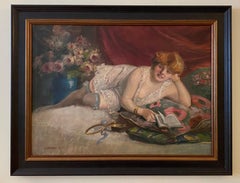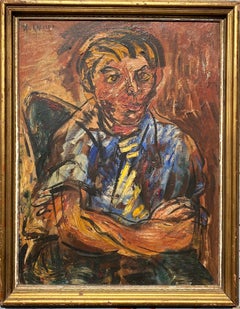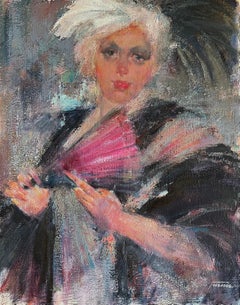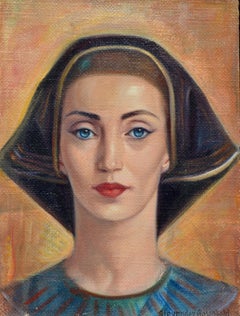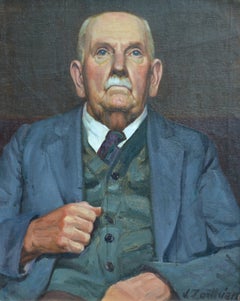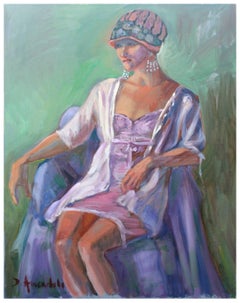Items Similar to Alexandria
Want more images or videos?
Request additional images or videos from the seller
1 of 5
Buckley MacGurrinAlexandria1949
1949
About the Item
BUCKLEY MACGURRIN
"ALEXANDRIA"
OIL ON CANVAS, SIGNED, TITLED
AMERICAN, DATED 1949
EXHIBITED: DALZELL-HATFIELD GALLERY
14 X 20 INCHES
Buckley MacGurrin
1896 –1971
Buckley MacGurrin was born in Kalamazoo, Michigan in 1896 to Irish-American parents. In 1912 he moved with his family to Salt Lake City, UT. After graduating from High School, he enrolled at UC Berkeley, but after his first semester he left to join the Navy. He served for two and half years during WWI.
After the war, MacGurrin returned to Berkeley and graduated in 1922. He then moved to Hollywood and began working as a designer for the movie studios. After deciding to become a full-time artist, MacGurrin moved to Paris, where he could further his studies. He remained in Paris from 1922-1933. He attended the Académie Colarossi and also studied the masterpieces at the Louvre.
At Colorossi, MacGurrin studied under Richard Miller, Charles Guerin, Richard Navdin, and his primary mentor and close friend, Henry Morisset. In 1926 he was invited to exhibit at the Salon des Tuilleries. That same year he also exposed at the Salon des Humoristes, and the Salon du France at the gallery Armand Drouant, at which one of MacGurrin’s paintings was acquired by the French State. He would continue to exhibit at the Salon des Tuilleries for seven more years, the remainder of his time in France.
In 1933 he returned to the States, spending six months in New York before moving back to Los Angeles. His work was represented by Carl Stendahl, whose Stendahl Gallery was at that time located on Wilshrie Boulevard, and MacGurrin also kept a studio in the gallery. His first one-man show was in 1933 at Stendhal. Around 1937, MacGurrin changed gallery representation to Dalzell Hatfield Gallery. He also continued to exhibit in Paris, showing his work there at the Salon d’Automne from1929-1937.
MacGurrin also worked for Paramount Pictures during this time, designing sets and props for the renowned director Cecil B. De Mille. He worked on the first Federal Art Project in 1933, executing murals around Los Angeles, including on in the cafeteria of the Los Angeles County Art Museum called “Gastronomy Through the Ages”. In 1934 MacGurrin was invited to work on the second Federal Art Project, eventually becoming the supervisor for Los Angeles County and Santa Barbara. He remained the supervisor until leaving the project in 1938.
After retiring from the Art Project, he took up a teaching position at the San Antonio Art Institute, which incidentally housed one of the best collections of modern French painting west of New York. He did not live full time in Texas however, and always maintained residence in southern California, teaching only part of the year. MacGurrin’s work with the Federal Art Project is significant not only for the numerous murals and other public works he created during his time, but also for the generation of younger artists he taught and inspired. MacGurrin’s work is represented in the collections of the Frederick R Weisman Art Museum, Minneapolis, Minnesota; San Gabriel Mission; LACMA (cafeteria mural); LA County Hall of Records; Santa Paula High School; Long Beach Public Library; Museum of Natural History (LA); and the Marion Koogler McNay Art Museum, San Antonio, Texas.
MacGurrin died in Los Angeles on July 16, 1971.
About the Seller
5.0
Vetted Professional Seller
Every seller passes strict standards for authenticity and reliability
Established in 1972
1stDibs seller since 2011
403 sales on 1stDibs
Typical response time: <1 hour
- ShippingRetrieving quote...Shipping from: Los Angeles, CA
- Return Policy
Authenticity Guarantee
In the unlikely event there’s an issue with an item’s authenticity, contact us within 1 year for a full refund. DetailsMoney-Back Guarantee
If your item is not as described, is damaged in transit, or does not arrive, contact us within 7 days for a full refund. Details24-Hour Cancellation
You have a 24-hour grace period in which to reconsider your purchase, with no questions asked.Vetted Professional Sellers
Our world-class sellers must adhere to strict standards for service and quality, maintaining the integrity of our listings.Price-Match Guarantee
If you find that a seller listed the same item for a lower price elsewhere, we’ll match it.Trusted Global Delivery
Our best-in-class carrier network provides specialized shipping options worldwide, including custom delivery.More From This Seller
View AllRelaxing
By Richard Geiger
Located in Los Angeles, CA
RICHARD GEIGER
"RELAXING"
OIL ON CANVAS, SIGNED
HUNGARIAN, C.1930
28 X 39 INCHES
FRAMED 36.5 X 46 INCHES
Richard Geiger
1870-1945
Richard Geiger was born in Vienna and first studied at the Vienna Art Institute with the academic painter Christian Ludwig Von Griepenkerl and, subsequently, in Paris with Francois Flameng...
Category
1930s Art Deco Portrait Paintings
Materials
Canvas, Oil
$1,625 Sale Price
50% Off
Man with Yellow Tie
Located in Los Angeles, CA
ALEXANDER KREISEL
"MAN WITH YELLOW TIE"
OIL ON CANVAS BOARD, SIGNED
RUSSIAN-AMERICAN, C.1935
26 X 19.5 INCHES
FRAMED 29.5 X 23.5 INCHES
Alexander Krei...
Category
1930s Expressionist Figurative Paintings
Materials
Canvas, Oil
$1,688 Sale Price
24% Off
LADY WITH PICK FAN
Located in Los Angeles, CA
Biography from the niece of the artist from during his lifetime. Paintings acquired from the artist.s estate.
Max Turner
1925 - 2019
Max Lamar Turner Painter, Sculptor, Teacher and Author.
Max Turner was born in Omaha, Nebraska on July 28, 1925. His father was Lance Howard Turner and his mother Mary Irene Turner. In 1927, his family moved to Bingham Canyon, Utah where Max's father extracted copper from a creek that he had diverted to pass through his garage. The town was located in a narrow canyon on the eastern face of the Oquirrh Mountains. In 1938, when Max was 13, his family moved to Midvale, Utah. After completing high school, Max went to work laying rail until he was inducted into the U.S. Navy to serve during W.W. II.
There he took an aptitude test and was initially assigned to the medical corp., later transferring to the dental unit. Max was stationed at Port Hueneme, Ventura County, California through the end of the war. When he was discharged in 1946, he remained in Southern California, living in the Los Angeles area. He met a man named Larry Torres and they formed a partnership to do silk screen work primarily for the Colby Poster Printing Company. This lasted about 10 years until the Colby building caught fire and burned down. In 1958, Max began working for Slade Novelty company that made doll parts using a product called plastisol. A year later, Max began producing plastic parts through his own business. One day, a couple of kids brought in a shrunken skull they had made and asked Max if he could reproduce it. Max said he could and he looked around for a business to work with for this task. He ultimately decided he could create his own machine shop to make molds. As a result, Max purchased a lathe, drill press, grinder and other tools to create his own machine shop and went into business making molds. He built a clientele and in 1973, he moved his machine shop to Glendale, California.
Painter, Sculptor, Teacher and Author:
Max recalls the day when his interest in art took a new direction. He happened to be in a paint store to purchase some supplies when he saw a card posted on a wall that read, "Come paint with Connie Marlo". Max had been interested in art since his youth and he was frequently impressed with paintings displayed by local artists at various community events.
Consequently, he decided to go to Connie's Saturday morning art class at a studio on North La Brea Avenue (between Sunset and Hollywood) in Los Angeles. But, as fate would have it, he immediately took a detour from this class when he found a piece of paper on the floor of the studio referencing another art class dealing with compositions, patterns, rhythms and color harmony. The instructor's name was Hal Reed, a former art student of the Russian/American Master, Nicolai Fechin. Hal owned the building (previously the Will Foster Studio) and had founded the Art League of Los Angeles. When Max found Hal, he asked Hal if he could join his class. Hal said "No, the class was full" but he said Max could monitor the class in the back of the classroom. Max took him up on the offer and began observing the weekly class.
During the class, Hal told his students that they should practice what they were learning by going to "live model" classes. Max began attending these classes where he learned how to draw figures. After a few months, Hal and Max became good friends. Hal was so impressed with Max's work that he offered Max the opportunity to teach at another location that Hal was opening in the San Fernando Valley. Max accepted the offer and began teaching his own art class. For Max, it was a quick jump from learning to teaching. Max then found that several of his students had to commute to his art class from the west end of the "Valley". To better serve this group of students, Max decided to relocate to another studio in Calabasas.
Max continued teaching, and at this time he was producing very impressive portraits, both oil paintings and charcoal drawings from live models (Max never worked from photos). Max demonstrated real talent, and the style of his drawings and paintings were being compared to those of Nicolai Fechin. And, like Fechin, Max also had an interest in sculpting. One day, Max decided to design and cast a bronze owl sculpture to put in his Calabasas Fine Art Gallery. Later, someone approached Max when he was at the foundry and asked him about his success selling the owl sculpture. The individual who asked this question was convinced that there was a broader market for these sculptures and he ordered a dozen of the owl sculptures from Max. This encouraged Max to do more castings. Some of the new castings were antique sculptures he found and reproduced. As this new business grew, he decided to establish his own foundry, employing up to 15 workers. The business continued for many years, up until the late 1990's when Max got tired of the foundry business and sold it.
Max, who was now in his 70's, decided to move on to his next venture as an artist, dedicating himself to doing the actual sculpting of original art. He loved the creativity of sculpting and he had his sculptures cast at local foundries, ironically the same ones that used to be his competition. Max was now fully engaged in his new artistic direction and, over time, he produced a large body of work. He created very impressive sculptures, including about 100 full-size sculptures. He sold some of these to high-end clientele, the Foundry at SLS Las Vegas, and to Hollywood studios.
Even though Max now seemed to be totally in his element, he somehow also found time to continue to teach painting classes at the California Art Institute in Westlake Village in Los Angeles. At the institute, he specialized in figure work. Max continued to draw, paint and teach, but he says he stopped sculpting when he turned 90.
Max produced four books showcasing his drawings and paintings. The first is "Faces, The Drawings of Max Turner", copyright 2000, that showcases nearly 100 of his portrait drawings. Within the "Acknowledgements" section, he lists Hal Reed and Joseph Nordmann, two former students of Nicolai Fechin.
In 2006, Max produced his second book titled "Figures and Faces", reflecting not only portraits but also figure drawings and paintings. It is a wonderful book of Max's work, but it is currently difficult to find. The third book is titled "Faces 2, The Paintings and Drawings of Max Turner", copyright 2009, which includes 75 portrait paintings and drawings. In the "Preface" of this book, Max describes growing up in a small and isolated mining town during the Great Depression. He states that as a kid, he had little exposure of any culture or view of what the rest of the world was like. His neighbor was the trash collector and Max would sometimes go through his truck looking for anything of value. Among other things, he found magazines like Cosmopolitan, Good Housekeeping and Red Book, with covers that frequently showed drawings or paintings of faces. Max states that these images were the very first source of inspiration for him. He says that he began looking more carefully at people's faces and if they had character, he would draw them. By drawing them, Max says that he was making them part of his world, his world of "Faces".
In 2018, Max published his newest book showcasing his drawings and paintings. It is titled "Max Turner's Figure Sketches". This softbound book includes 76 pages and over 120 drawings and paintings. In the Introduction, Max explains "I have found that when approaching the figure, one should begin with the gesture. After having captured the essence or feeling of the pose, one can then proceed to build on it." The figure sketches in this wonderful book reflect a Master's work that consistently captures the "gesture"-showing the emotion, movement and expression.
Two more books are on the horizon for Max, both dealing with his passion for sculpting. His first, "The Sculpture of Max Turner" is a compilation of his commercial and noncommercial pieces throughout his career. The second, "Terra Cotta Sculpture by Max Turner" is a complete collection of figures done at the California Art Institute. These much anticipated books should be out later in 2018.
Max now considers himself primarily a sculptor. But others in the art world are more than impressed with his drawings and paintings as well. His portraits are often described as having a Fechin-esque appearance, referring to the style of Nicolai Fechin. When Max observed those first art classes given by Hal Reed, it should be noted that Hal had previously been a student of the Russian/American Master Nicolai Fechin in the early to mid-1950's. In fact, Hal was a student in the last art class that Fechin taught before he unexpectedly died in 1955. Hal was so strongly influenced by Fechin that he later produced two 30-minute art instruction videos as part his Art Video Productions wherein he specifically described Fechin techniques that he learned in Fechin's class. The Fechin style and techniques were in play when Max later met Hal. Over the years, many of Max's art students, art collectors, gallery owners, as well as the Director of the Monterey Museum of Art have commented on the Fechin-esque qualities of Max's wonderful charcoal drawings and paintings. So, while Max may consider himself primarily a sculptor, his drawings and paintings are also impressive and very much sought after.
When Nicolai Fechin died in 1955, three of the nine students in his last art class became life-long friends. Max subsequently became friends with not only Hal Reed, but also with prior Fechin students Joseph Nordmann and Albert Londraville...
Category
1990s Modern Figurative Paintings
Materials
Canvas, Oil
$450 Sale Price
64% Off
BLONDE WITH ART DECO NECKLACE
Located in Los Angeles, CA
Biography from the niece of the artist from during his lifetime. Paintings acquired from the artist.s estate.
Max Turner
1925 - 2019
Max Lamar Turner Painter, Sculptor, Teacher and Author.
Max Turner was born in Omaha, Nebraska on July 28, 1925. His father was Lance Howard Turner and his mother Mary Irene Turner. In 1927, his family moved to Bingham Canyon, Utah where Max's father extracted copper from a creek that he had diverted to pass through his garage. The town was located in a narrow canyon on the eastern face of the Oquirrh Mountains. In 1938, when Max was 13, his family moved to Midvale, Utah. After completing high school, Max went to work laying rail until he was inducted into the U.S. Navy to serve during W.W. II.
There he took an aptitude test and was initially assigned to the medical corp., later transferring to the dental unit. Max was stationed at Port Hueneme, Ventura County, California through the end of the war. When he was discharged in 1946, he remained in Southern California, living in the Los Angeles area. He met a man named Larry Torres and they formed a partnership to do silk screen work primarily for the Colby Poster Printing Company. This lasted about 10 years until the Colby building caught fire and burned down. In 1958, Max began working for Slade Novelty company that made doll parts using a product called plastisol. A year later, Max began producing plastic parts through his own business. One day, a couple of kids brought in a shrunken skull they had made and asked Max if he could reproduce it. Max said he could and he looked around for a business to work with for this task. He ultimately decided he could create his own machine shop to make molds. As a result, Max purchased a lathe, drill press, grinder and other tools to create his own machine shop and went into business making molds. He built a clientele and in 1973, he moved his machine shop to Glendale, California.
Painter, Sculptor, Teacher and Author:
Max recalls the day when his interest in art took a new direction. He happened to be in a paint store to purchase some supplies when he saw a card posted on a wall that read, "Come paint with Connie Marlo". Max had been interested in art since his youth and he was frequently impressed with paintings displayed by local artists at various community events.
Consequently, he decided to go to Connie's Saturday morning art class at a studio on North La Brea Avenue (between Sunset and Hollywood) in Los Angeles. But, as fate would have it, he immediately took a detour from this class when he found a piece of paper on the floor of the studio referencing another art class dealing with compositions, patterns, rhythms and color harmony. The instructor's name was Hal Reed, a former art student of the Russian/American Master, Nicolai Fechin. Hal owned the building (previously the Will Foster Studio) and had founded the Art League of Los Angeles. When Max found Hal, he asked Hal if he could join his class. Hal said "No, the class was full" but he said Max could monitor the class in the back of the classroom. Max took him up on the offer and began observing the weekly class.
During the class, Hal told his students that they should practice what they were learning by going to "live model" classes. Max began attending these classes where he learned how to draw figures. After a few months, Hal and Max became good friends. Hal was so impressed with Max's work that he offered Max the opportunity to teach at another location that Hal was opening in the San Fernando Valley. Max accepted the offer and began teaching his own art class. For Max, it was a quick jump from learning to teaching. Max then found that several of his students had to commute to his art class from the west end of the "Valley". To better serve this group of students, Max decided to relocate to another studio in Calabasas.
Max continued teaching, and at this time he was producing very impressive portraits, both oil paintings and charcoal drawings from live models (Max never worked from photos). Max demonstrated real talent, and the style of his drawings and paintings were being compared to those of Nicolai Fechin. And, like Fechin, Max also had an interest in sculpting. One day, Max decided to design and cast a bronze owl sculpture to put in his Calabasas Fine Art Gallery. Later, someone approached Max when he was at the foundry and asked him about his success selling the owl sculpture. The individual who asked this question was convinced that there was a broader market for these sculptures and he ordered a dozen of the owl sculptures from Max. This encouraged Max to do more castings. Some of the new castings were antique sculptures he found and reproduced. As this new business grew, he decided to establish his own foundry, employing up to 15 workers. The business continued for many years, up until the late 1990's when Max got tired of the foundry business and sold it.
Max, who was now in his 70's, decided to move on to his next venture as an artist, dedicating himself to doing the actual sculpting of original art. He loved the creativity of sculpting and he had his sculptures cast at local foundries, ironically the same ones that used to be his competition. Max was now fully engaged in his new artistic direction and, over time, he produced a large body of work. He created very impressive sculptures, including about 100 full-size sculptures. He sold some of these to high-end clientele, the Foundry at SLS Las Vegas, and to Hollywood studios.
Even though Max now seemed to be totally in his element, he somehow also found time to continue to teach painting classes at the California Art Institute in Westlake Village in Los Angeles. At the institute, he specialized in figure work. Max continued to draw, paint and teach, but he says he stopped sculpting when he turned 90.
Max produced four books showcasing his drawings and paintings. The first is "Faces, The Drawings of Max Turner", copyright 2000, that showcases nearly 100 of his portrait drawings. Within the "Acknowledgements" section, he lists Hal Reed and Joseph Nordmann, two former students of Nicolai Fechin.
In 2006, Max produced his second book titled "Figures and Faces", reflecting not only portraits but also figure drawings and paintings. It is a wonderful book of Max's work, but it is currently difficult to find. The third book is titled "Faces 2, The Paintings and Drawings of Max Turner", copyright 2009, which includes 75 portrait paintings and drawings. In the "Preface" of this book, Max describes growing up in a small and isolated mining town during the Great Depression. He states that as a kid, he had little exposure of any culture or view of what the rest of the world was like. His neighbor was the trash collector and Max would sometimes go through his truck looking for anything of value. Among other things, he found magazines like Cosmopolitan, Good Housekeeping and Red Book, with covers that frequently showed drawings or paintings of faces. Max states that these images were the very first source of inspiration for him. He says that he began looking more carefully at people's faces and if they had character, he would draw them. By drawing them, Max says that he was making them part of his world, his world of "Faces".
In 2018, Max published his newest book showcasing his drawings and paintings. It is titled "Max Turner's Figure Sketches". This softbound book includes 76 pages and over 120 drawings and paintings. In the Introduction, Max explains "I have found that when approaching the figure, one should begin with the gesture. After having captured the essence or feeling of the pose, one can then proceed to build on it." The figure sketches in this wonderful book reflect a Master's work that consistently captures the "gesture"-showing the emotion, movement and expression.
Two more books are on the horizon for Max, both dealing with his passion for sculpting. His first, "The Sculpture of Max Turner" is a compilation of his commercial and noncommercial pieces throughout his career. The second, "Terra Cotta Sculpture by Max Turner" is a complete collection of figures done at the California Art Institute. These much anticipated books should be out later in 2018.
Max now considers himself primarily a sculptor. But others in the art world are more than impressed with his drawings and paintings as well. His portraits are often described as having a Fechin-esque appearance, referring to the style of Nicolai Fechin. When Max observed those first art classes given by Hal Reed, it should be noted that Hal had previously been a student of the Russian/American Master Nicolai Fechin in the early to mid-1950's. In fact, Hal was a student in the last art class that Fechin taught before he unexpectedly died in 1955. Hal was so strongly influenced by Fechin that he later produced two 30-minute art instruction videos as part his Art Video Productions wherein he specifically described Fechin techniques that he learned in Fechin's class. The Fechin style and techniques were in play when Max later met Hal. Over the years, many of Max's art students, art collectors, gallery owners, as well as the Director of the Monterey Museum of Art have commented on the Fechin-esque qualities of Max's wonderful charcoal drawings and paintings. So, while Max may consider himself primarily a sculptor, his drawings and paintings are also impressive and very much sought after.
When Nicolai Fechin died in 1955, three of the nine students in his last art class became life-long friends. Max subsequently became friends with not only Hal Reed, but also with prior Fechin students Joseph Nordmann and Albert Londraville...
Category
1990s Modern Figurative Paintings
Materials
Canvas, Oil
$650 Sale Price
48% Off
UNTITLED
By Sofia Ruiz
Located in Los Angeles, CA
"UNTITLED"
OIL AND ACRILIC ON CANVAS
SIGNED
35.5 X 27.5 INCHES
Sofía Ruiz was born in 1982.
What she expresses through her paintings has to do with whe...
Category
2010s Surrealist Figurative Paintings
Materials
Canvas, Oil, Acrylic
$6,500
SUENO PROFUNDO
By Sofia Ruiz
Located in Los Angeles, CA
SUENO PROFUNDO
OIL AND ACRILIC ON CANVAS
SIGNED, 2013
EXHIBITED MUSEO DEL BANCO CENTRAL
DE COSTA RICA
43.25 X 35.5 INCHES
Sofía Ruiz was born in 1982....
Category
2010s Surrealist Figurative Paintings
Materials
Canvas, Oil, Acrylic
You May Also Like
The Princess
By Alexander Rosenfeld
Located in West Hollywood, CA
Presenting an original oil on canvas by American artist Alexander Rosenfeld.
Rosenfeld was classically trained in Poland before settling in Los An...
Category
1940s Art Deco Figurative Paintings
Materials
Canvas, Oil
Price Upon Request
The Old Gentleman
By Jirayr Hamparzoom Zorthian
Located in West Hollywood, CA
Jirayr Hamparzoom Zorthian was born April 14, 1911 in Kutahya, Turkey, of Armenian parents. At the age of three, he showed considerable talent in drawing and painting.
Zorthian went through two Turkish massacres before age eight. He left Turkey at age nine with his family and spent a year in Padua, Italy, waiting for his visa to open to the United States. This period was very important in his life because his father took him to many cities in Europe and exposed him to great works of art.
Zorthian arrived in the United States at the age of eleven and settled with his family in New Haven, Connecticut. He obtained his formal education there, after graduating from Yale, the Winchester Fellowship granted him a year and a half at the American Academy in Rome with travel and study throughout Europe.
His art career branched into various directions on his return to the United States. As a mural painter his reputation was established. He has forty two (42) murals throughout the United States. Zorthian worked and taught painting at some of the finest art academies on the west coast including both the Chouinard Art Institute and the Otis Art Institute.
The Old Gentleman...
Category
1930s Art Deco Figurative Paintings
Materials
Canvas, Oil
Price Upon Request
Male Portrait, Signed Gennaro Befanio (Naples, 1866 - Paris, 1937), Dated 1936
Located in Firenze, IT
Male Portrait, Signed Gennaro Befanio (Naples, 1866 - Paris, 1937), Dated 1936
Male portrait in oil on canvas, signed in the upper left corner "G. Befanio" and dated 1936.
Likely on...
Category
Early 20th Century Art Deco Portrait Paintings
Materials
Canvas, Oil
Portrait of a Woman in Purple - Parisian Art Deco Female Figurative
By Dominique Amendola
Located in Soquel, CA
Portrait of a Woman in Purple - Parisian Art Deco Female Figurative
Colorful and quirky art deco style figure painting of a seated Parisian woman dressed in light purple with decora...
Category
1990s Art Deco Figurative Paintings
Materials
Canvas, Oil, Stretcher Bars
Writer Fannie Hurst in Floral Pattern Dress Bathed in Warm Light Female Artist
By Edna Crompton
Located in Miami, FL
This portrait of Fannie Hurst may have graced
the cover of another major newsstand magazine.
Most likely, it was a non-published alternate cover for Redbook.
One of the most widely-read female authors was painted by one of the most widely-viewed female illustrators.
Edna Crompton was an in-demand and prolific for-hire female illustrator/artist for some of the most prestigious newsstand magazines of the day. She regularly did covers for the Saturday Evening Post, Redbook, Colliers and Judge to name a few. Crompton presents Fannie Hurst - the nation’s highest-paid short story writer and advocates for suffrage and race relations - as a confidently attractive young woman bathed...
Category
1920s Art Deco Portrait Paintings
Materials
Canvas, Oil
A Chinese Company playing Droughts
Located in Amsterdam, NL
ERWIN BINDEWALD (1897-1950)
Two men playing draughts, a girl with the red book standing behind them
Signed and dated E. Bindewald d.j., 27
Oil on canvas, 140.5 x 90.5 cm
In black and gilt gesso frame.
Note:
Bindewald was born in Charlottenburg. He moved to Berlin in 1914 where he studied till 1924 at the Berliner Kunst Akademie. Bindewald travelled in Europe, but mainly stayed in Germany and certainly never was in China. This painting was made in Europe, presumably in the China Town of Berlin. Bindewald received several commisions in Germany from factory owners who wanted their factories painted inside, usually with workers, as well as outside. In the present painting the sitter on the right seems to be a man with a Manchurian background, wearing the brown coat reserved for the highest aristocracy in China.
In China the black sleeve-ends completely cover the hands, indicating that the high aristocracy does not have to do any manuel labour. This man clearly is not a factory worker but he possibly is the (co)- owner of the factory in the background and as such might need his hands to do at least some writing. The man on the left in the modern Western suit...
Category
1920s Art Deco Portrait Paintings
Materials
Canvas, Oil
Recently Viewed
View AllMore Ways To Browse
Art Deco Los Angeles
Ireland Inspired Art
California Art Deco
Paramount Pictures
Irish Art Deco
French Painting Boulevard
Generations 1912
Hollywood Props
Used Hollywood Props
Wwi Paris
Art Deco Murals
Art Deco Movie
Fredericks Of Hollywood
Marion Miller
Lake Michigan Oil Painting
San Antonio Missions
Frederick Miller
Art Deco Props
